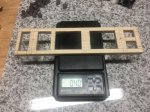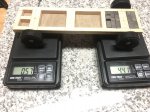District car underway
- Thread starter Eric
- Start date
You are using an out of date browser. It may not display this or other websites correctly.
You should upgrade or use an alternative browser.
You should upgrade or use an alternative browser.
Being in the woodworking- furniture restoration field for over 20 years. Wood doesn't warp if it is sealed relatively to cutting a thin plank. This keeps the moisture content the same. What warps wood is either the lost of moisture or introducing more moisture than the wood has in the grain currently. Hence is why most wood will shrink alot perpendicular to the grain lines, but not much the other way. I've seen furniture from the 1700s shrink as much as 1-2" over about a 36" length. Depending on the wood species. FYI.Keep us up to date! Safety first!
Kind of curious if the wood actually warps at this point.
Last edited:
Nice job teaching your son how to build cars.
I have a question. I have a planer as well. I never noticed any of my car blanks warping. I cut several blanks,plan them and throw them inzip lock bag for storage. Is it really necesary to let them rest to see if they warp before using them?
I have a question. I have a planer as well. I never noticed any of my car blanks warping. I cut several blanks,plan them and throw them inzip lock bag for storage. Is it really necesary to let them rest to see if they warp before using them?
The only reason we did it was because I was curious. I would totally agree with Rocket Cars post. Unsealed wood will gain or lose moisture causing the wood to shrink or swell, depending on the environment it is stored in. We can get what little bit of warpage it has out by planing the remaing .01 that we left. Will it curl up again after we do this, probably but it is a very small amount.Nice job teaching your son how to build cars.
I have a question. I have a planer as well. I never noticed any of my car blanks warping. I cut several blanks,plan them and throw them inzip lock bag for storage. Is it really necesary to let them rest to see if they warp before using them?
We have the boys car about done and ready to start testing on the track. What number should we shoot for on COM. As the car sits now COM is 5/8 in front of the rear axle. We have .57 oz. on the front wheel and 4.41 oz. on the rears. Wheelbase is 5 inches.
Thanks, Eric
Thanks, Eric
Attachments
We will be running on both Wood and Aluminum tracks from what I have heard. I have made a triangle by connecting all the axle points with the goal of keeping the weights in front of the axle within that triangle. This is making for some goofy looking weight placement. As the car sits in these pictures COM is 13/16 (wheels and axles where I for this, removed for the pic). We will start testing/experimenting tonight with moving weights around.If your running on a aluminum track 5/8 is fine. Don't go back any further.
Yes, no rules about where we place the axles, moving the rear back another 1/4 inch is already in the plan for our next car. We/I left a lot of wood in the car trying to make it as robust as it could be, since we are talking about seven year olds. Lol. At the Pack race he was very responsible and he got real serious with staging his car once he realized how important that part of the race can be.Next year I would move the axle back (if you're allowed) & cut your weight pockets wider to get two rows of six behind the axle. This will help get more weight to the rear of the car.
Your son did a great job, nicely done!
We have an adult only race coming up, we will build that car together, but we will build it with the next set of improvements and I will not worry about if it breaks or not. lol
We got the the car on the track last night. We played with it for an hour, moving weights around and loosening the steering up and then slowly bringing it back to where the wiggles stopped. It did not have the improvement that we where hoping for. Removed the axles and wheels then reassembled them back on his first car. We got it dialed in pretty quickly, his first car is now .006 fater then the new car on a 32' wood track. His first car has improved .010 since we first started running it on the track we bought. Things that make you go hmmm.....
If one body is faster than another body using the same wheels and axles, I would pretty much assume that the drill on the slower car is off if both cars are weighted similarly.
As it was pointed out, you could use more weight behind the rear axle than just ten cubes, You could try taping a tungsten plate underneath the rearmost part of the car?
As it was pointed out, you could use more weight behind the rear axle than just ten cubes, You could try taping a tungsten plate underneath the rearmost part of the car?
Good eye!! That issue was was fixed a few days after his pack race.Eric, I am no Pro like these other guys. I am wondering if the car your son is staging is the one you are testing and talking about? (Black with Blue wheels)If it is, it looks like your DFW is canted the wrong way. It should be the opposite of the back wheels.
First body is the top picture, with 5.5 wheelbase. COM on this one was just shy of 1 inch.If one body is faster than another body using the same wheels and axles, I would pretty much assume that the drill on the slower car is off if both cars are weighted similarly.
As it was pointed out, you could use more weight behind the rear axle than just ten cubes, You could try taping a tungsten plate underneath the rearmost part of the car?
Second body was drilled with the SBP, 5 inch wheelbase and COM was adjusted from 13/16 all the way down to 1/2 inch while we tested. I guess I need to go back and check the alignment on it.
Last edited:
Clean the wheels...Always speed to be found there. Always.We got the the car on the track last night. We played with it for an hour, moving weights around and loosening the steering up and then slowly bringing it back to where the wiggles stopped. It did not have the improvement that we where hoping for. Removed the axles and wheels then reassembled them back on his first car. We got it dialed in pretty quickly, his first car is now .006 fater then the new car on a 32' wood track. His first car has improved .010 since we first started running it on the track we bought. Things that make you go hmmm.....
Similar threads
- Replies
- 12
- Views
- 2K
- Replies
- 11
- Views
- 9K
- Replies
- 5
- Views
- 7K
- Replies
- 15
- Views
- 3K


